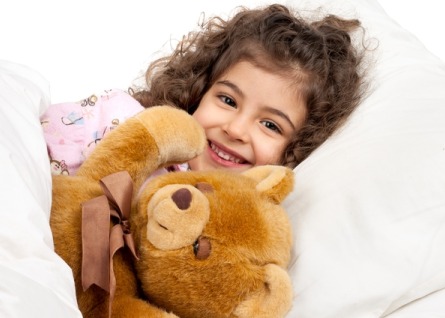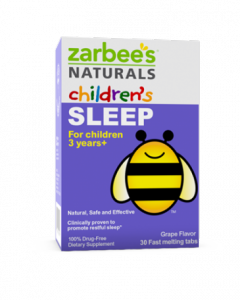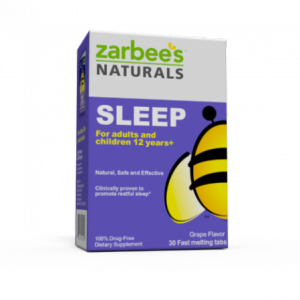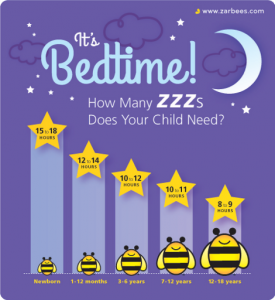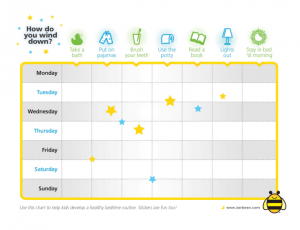Zarbee’s Sleep and Zarbee’s Children’s Sleep, formulated for children 3 years and older, are safe and effective remedies for occasional sleeplessness*. The exclusive formulas feature clinically proven melatonin and l-theanine to promote restful sleep and relaxation. The ingredients in Zarbee’s Sleep and Zarbee’s Children’s Sleep are natural, non-habit forming and won’t leave you or your loved ones feeling groggy the next day*.
Pediatrician developed and recommended Zarbee’s Children’s Sleep contains 1 mg of clinically proven melatonin to promote restful sleep in children 3 years+. The grape-flavored chewable tablets make dosing a breeze for parents.
It’s important to note, Zarbee’s has selected an exceptionally pure and synthetic source for melatonin. Therefore, it is not derived from animals and is virtually identical to what your body naturally releases as part of its sleep cycle.
Better rest without the worry! Give you and your family members the gift of refreshing and revitalizing sleep. Find Adult sleep at Wal-Mart stores and the Children’s Sleep at your local Target or CVS stores.
* These statements have not been evaluated by the Food and Drug Administration. This product is not intended to diagnose, treat, cure of prevent any disease.
Other Useful Tips and Resources for Better Quality Sleep:
Dr. Rebecca Kempton, of BabySleepPro.com has made a career out of making sure you and your kids are getting the sleep you need. Check out these useful 5 Toddler Sleep Tips:
- Avoid the “crankfest” with a well-timed bed time. One common problem is a bedtime that is too late. With their bodies in constant motion most of the day, toddlers need adequate time to wind down before an early bedtime. By the time they become cranky, they are already overtired; getting an overtired child to sleep is like trying to nail jelly to a tree. That’s because they get a second wind (when their bodies produce cortisol to fight fatigue.) To avoid triggering this response, make sure your toddler is in bed and sleeping within 4 hours from the end of his afternoon nap. To accomplish an early bedtime, wind down should begin 30 minutes before. Typical toddlers who nap from roughly 1-3:00 should aim for a bedtime no later than 7:00 p.m. If they skip a nap, then bedtime should come as early as 5:30-6pm. Every child has different patterns so train your eyes on their on their behavior to hit the right bedtime.
- Ignore those “curtain calls”. He’s in bed, the lights are out and you have just left the room with a sigh of relief when the requests begin: “Mommy, I want a glass of water.” But most parents know how fast one request can turn into a litany of complaints: “Mommy, I can’t find my bear,” “Mommy, I’m hungry,” Mommy, I can’t remember how to sleep.” Each Mommy call makes you hesitate until you give in to “just one”. But the demands continue and may escalate. The best advice is to ignore them. If you can’t resist, go to their door and say “I can hear you, but it’s time for bed, go to sleep” and leave. Let them know you mean business and don’t linger. Unreinforced behavior will eventually disappear.
- Return the “runner” to bed, silently: As we know, toddlers can be fast, really fast. Just when you think you have successfully managed a calm bedtime routine, your toddler races out of bed. Even toddlers still in cribs can master this feat with the dexterity of a mountain goat on the side of a cliff. The solution is to take their hand and return them to bed as swiftly and silently as possible. Avoid saying anything; instead march them in silence back to bed. I have worked with families who have had to repeat this ritual more than 100 times before their child succumbed. So be persistent; eventually you will be successful. The key message you are sending is “I mean it when I say; it’s time for bed.
- Encourage independence so you don’t become “the pillow”: Just as you create a habit by feeding or rocking an infant to sleep, you can become a sleep “crutch” for your toddler if she needs YOU to fall asleep. If you make a habit of staying with her in the room until she falls asleep, then when she wakes up through sleep transitions (as everyone does), she will not fall back to sleep without you. And that’s the last place you want to be in the middle of the night! Instead make a habit of a loving bedtime routine with ample “you” time but then leave your child to fall asleep on her own– with any favorite stuffed animals, who will be more than happy to sleep with her.
- Manage nap transitions: Most toddlers’ transition from two naps to one between ages 15 and 18 months. Some toddlers may drop a nap at 12 months or earlier, but don’t jump the gun if you don’t need to! Here are a few signs to look for to know whether your toddler is ready to transition: when they consistently refuse one nap (and consistently means over the course of several weeks, not several days); when one nap becomes much shorter (usually the afternoon one); when the timing changes for a nap (your otherwise predictable nap schedule starts to go haywire with naps throughout the day, and sometimes too late in the day). Transitioning to one nap can take a few weeks, or even longer, for some. One trick is to slowly move the morning nap later by 15 minute increments every few days until you reach a midday nap that begins between 12 and 1 and lasts about 2 hours. During the transition period, your toddler may become more tired as they lose some of that day time sleep so be sure to compensate with an earlier bedtime.
Rebecca Kempton, M.D. Bio:
After graduating with a B.A. in Psychology from Dartmouth and an M.D. from Cornell Medical School, Rebecca Kempton worked for several years as a medical director for healthcare technology and pharmaceutical companies before becoming certified as an infant and toddler sleep consultant and starting her own business, Baby Sleep Pro. With her three children, aged five and under, along with dozens of clients nationwide, Rebecca has honed her sleep coaching skills. Using a variety of behavioral techniques, she customizes sleep solutions based on what she learns about you, your child, and your family’s goals; Rebecca works with clients nationwide by phone, video chats and email. For more information, email rhk@babysleeppro.com; visit babysleeppro.com and follow her on facebook.com/babysleeppro and twitter @babysleeppro
At Zarbee’s, sleep is a highly valued resource. Without sleep, health and happiness are negatively impacted. We’ve introduced our Adult and Children sleep aids to help you and your children get the sleep you need, naturally, drug-free, and without habit-forming ingredients.
Bedtime Routine Reward Charts:
